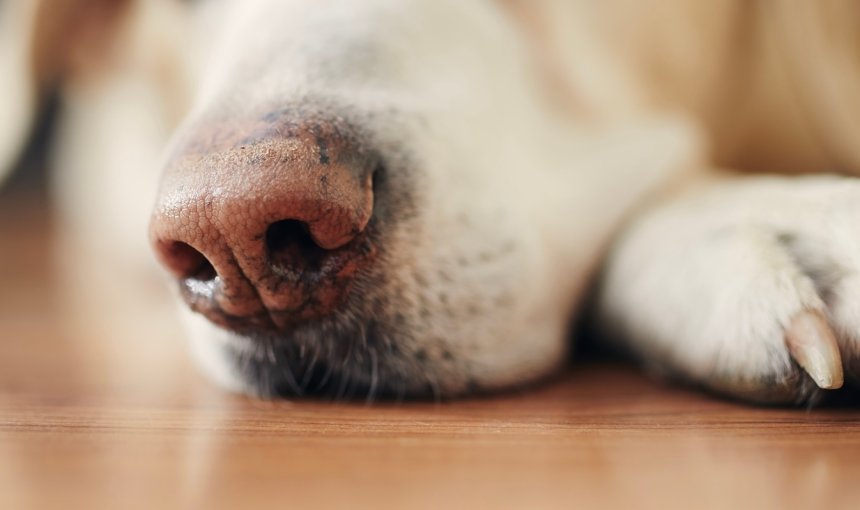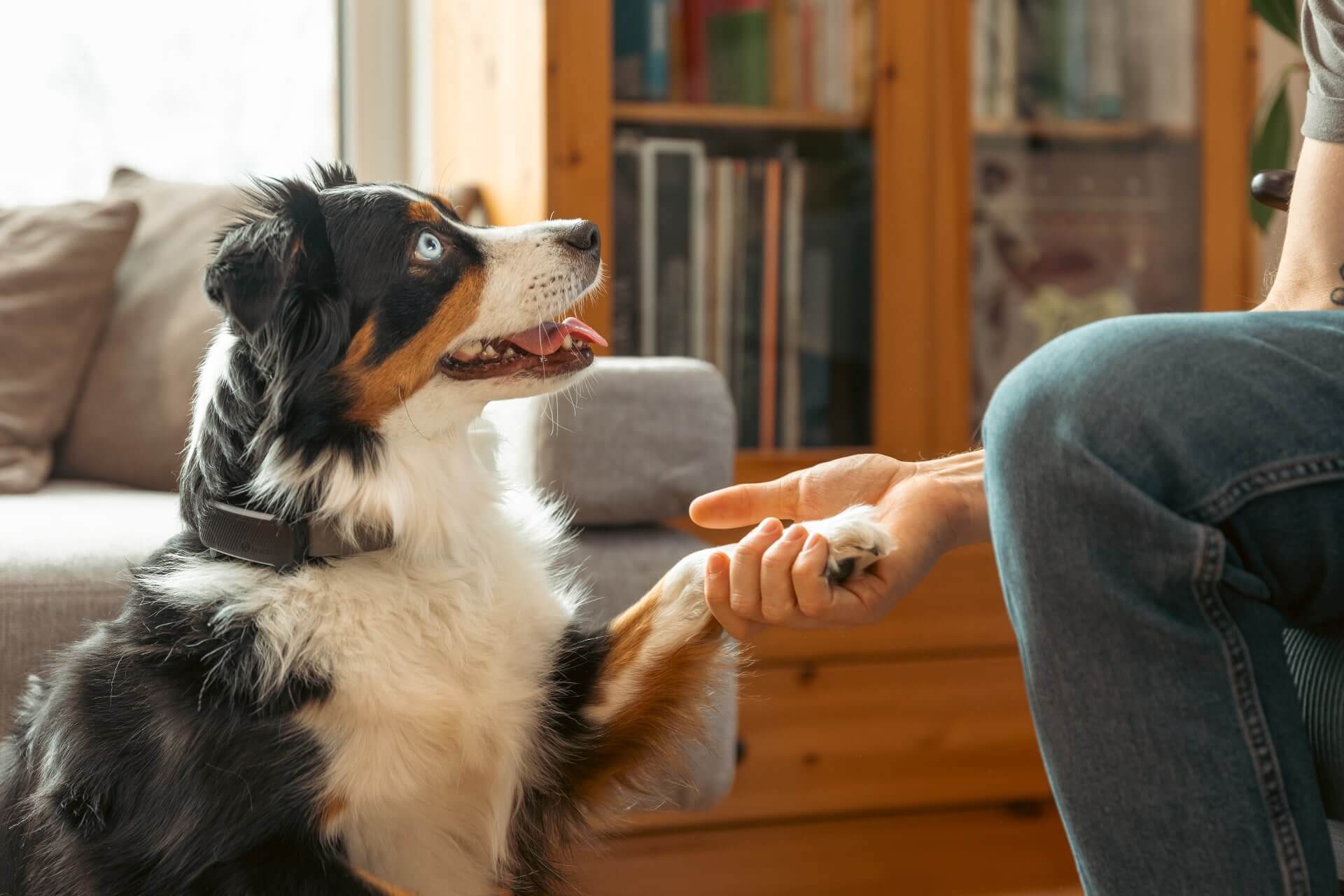 Approved by Dr. Dwight Alleyne, DVM
Approved by Dr. Dwight Alleyne, DVM Your Dog Respiratory Rate Guide: What’s Normal & What’s Not
With everything you do to keep your dog healthy, you do want to make sure you aren't missing out on the subtler, less obvious signs - like what counts as a normal dog respiratory rate. Our in-depth guide here has you covered.

Your dog’s respiratory rate is an important vital measure linked to their overall health. So in this post, we’re going to cover what’s a normal respiratory rate for dogs, what are the signs something could be wrong, and how tracking your buddy’s respiratory rate is key to picking up on a health issue early on. Let’s get started.

Always know your buddy is healthy & safe
Read more- What’s a normal respiratory rate for dogs?
- What counts as labored breathing in dogs?
- Why is my dog breathing weird? The more concerning reasons
- Why is my dog breathing weird – but less heavy than usual?
- How can I check my dog’s breathing rate at home?
- How to monitor changes in your dog’s breathing rate with Tractive
What’s a normal respiratory rate for dogs?
For dogs, a normal respiratory rate is considered 15-30 breaths per minute.1 But it does depend on factors like your dog’s:
| Size | Smaller dogs tend to breathe faster than medium- and large-sized dogs. This could be due to their smaller lung capacity and faster metabolisms. |
| Age | Puppies, likewise due to their smaller lung capacity and faster metabolisms, breathe faster than adult and senior dogs. However, senior dogs tend to be vulnerable to age-related health conditions, like heart or respiratory problems. Which could also make them breathe faster. |
| Breed | Brachycephalic dog breeds tend to have difficulties breathing in general because of how their skulls and snouts are shaped. They may be more vulnerable to sleep-related breathing disorders, like sleep apnea. On the other hand, physically active working dog breeds may pant faster after a long day of chasing around sheep, working in a K-9 unit, or pulling a sled over long distances. |
| Activity level | Panting is a normal response after vigorous exercise – and even more so among high-energy dog breeds. But it should taper off after a bit of time to cool down. On the other hand, dogs that are more sedentary might be more likely to become overweight with time. Which can also affect how easily they breathe. |
| Emotional state | Dogs may breathe faster when they’re stressed out, anxious, or frightened by something in their environment. Watch out for the usual culprits like loud noises, including fireworks or even thunderstorms. |
| Temperature | Dogs tend to pant to regulate their body temperature. So if it’s hot outdoors, they might pant more to cool down. Likewise, if you two are out hiking somewhere in the mountains (or somewhere higher in altitude), your dog might pant a bit more because of the lower levels of oxygen in the air. |
What counts as labored breathing in dogs?
If your dog is clocking in over 30 breaths per minute, they might be experiencing shortness of breath – or “dyspnea.” This type of labored breathing can occur both when they’re at rest or after a long walk or play session – and your dog might breathe harder and weirder than usual. This condition usually counts as a medical emergency – so get your dog to a vet right away if you notice:
- Rattling or gasping noises as your dog tries to breathe
- Wide, dilated pupils
- A bluish tongue and/or mucus membranes
- Heaving motions around your dog’s abdomen and ribs
💡Keep an ear out for how your dog breathes while they’re asleep. If they seem restless or move around a ton, it could be a sign of a deeper medical issue.
(Which you can actually track and pick up actionable data to share with your vet if you’ve invested in a smart tracker for dogs, which we’ll cover a bit further below.)
Why is my dog breathing weird? The more concerning reasons
No matter how much exercise they’ve gotten, how excited they are, or how hot (or cold) it is outdoors – your dog’s breathing should return to normal after a bit of rest. But if it doesn’t, it could be due to:
- Pain or chronic stress
Both of which can make your dog’s body struggle to cope with an increased demand for oxygen – and breathe harder as a result. This applies regardless of the underlying cause. - Foreign objects stuck in your dog’s throat
Which may cause them to cough, wheeze, or gag in an effort to release it. Splinters from sticks you throw for fetch, pieces of food, grass, or even toys can get lodged in their windpipes – leading to wheezing as your buddy tries to breathe normally. - Those few extra pounds
Excess weight puts extra strain on your dog’s heart and lungs – and makes it more likely they’ll wheeze, have to breathe harder, or faster to keep up with you.
Other conditions that might cause weird breathing in dogs
- Allergies
From environmental factors like pollen, mold, dust, secondhand smoke, and even the harsh chemicals in common household cleaning items. These allergens can inflame your buddy’s airways, leading to wheezing – and in some cases, anaphylaxis. - Infections
From viruses, bacteria or even fungi, which can lead to conditions like kennel cough. (Which is primarily spread from dog to dog.) - A collapsing trachea
- Heat stroke,
- Tumors or growths
In your dog’s lungs, trachea, and airways. - Respiratory issues
Including diseases like chronic bronchitis, pneumonia, or tracheal collapse. These tend to be more common among small breeds and brachycephalic dogs. - Parasites
Like, for example, lung worms which can cause inflammation and damage to your dog’s lung tissue, blood vessels, and airways. This might result in your dog sounding congested, since their lungs might have produced more mucus, which can block the airways. - Cardiovascular issues
Which can lead to difficulties transporting enough oxygen to your dog’s blood. This can lead to an increased respiratory rate, coughing, weakness, or bluish mucus membranes. - Other lung-related problems
Including pulmonary edema – or fluid buildup in your dog’s lungs. (Often as a result of heart problems.) - Injuries to your dog’s windpipe or chest
Whether from fighting another dog or animal, or even a too-vigorous bout of playtime.
Why is my dog breathing weird – but less heavy than usual?
A low breathing rate in dogs is generally a good thing – it usually means your buddy’s:
- Sleeping well,
- Relaxed and happy next to you on the couch,
- Getting fitter and healthier from exercise,
- Adjusting to the cold – meaning their bodies are trying not to lose warmth by breathing more,
Much like their heart rate, your dog’s breathing rate might drop when they’re very relaxed or asleep. In deep sleep, their breathing rate can drop even below 10 breaths per minute, which is 100% normal.
⚠️ Sadly, if your buddy’s breathing remains consistently low – it may also indicate nerve or heart problems. So besides keeping an eye out for signs like disturbed sleep, drop by your vet for a checkup.
How can I check my dog’s breathing rate at home?
Now we do understand if you’re worried if your dog sounds like they’re wheezing, breathing harder or heavier than usual, or even sound congested. Here’s how you can check their breathing rate at home:
- In a familiar, comfortable environment, get your dog to lie down in a relaxed position.
- Place your hand on your dog’s belly.
- Set a timer on your phone for 1 minute.
- Remember: one inhale and one exhale count as 1 breath.
- Count how many inhales and exhales your dog lets out within this 1 minute time limit.
Just make sure not to check your buddy’s breathing rate if they’ve just come home from a walk or running around the backyard all day! Panting doesn’t count as an increase in breathing, since the inhaled air doesn’t fully reach your dog’s lungs.
Your dog should be breathing between 15-30 breaths per minute – but don’t worry if it’s a bit less if your dog seems healthy otherwise. Their breathing should ideally seem smooth, without interruption.
How to monitor changes in your dog’s breathing rate with Tractive
With Tractive’s Respiratory Rate monitoring, you can establish their baseline breathing rate and see how this changes from day to day. Here’s how it works once you’ve attached your dog’s Tractive smart tracker to a well-fitted but comfortable collar – like so:

- Leave your tracker on for a week for up to 8 hours a day, including during periods of rest.
- Let Tractive establish their baseline resting respiratory rate (RRR).
- Check daily for fluctuations and keep an eye out if you notice a consistent decrease or increase in their RRR.
- With time, your Tractive device will figure out a baseline of your dog’s breathing rate – and help you spot a weird change much in advance:
So you can get your dog over to your vet for a checkup much before any budding health issue has a chance to worsen.

Help your dog stay fit and healthy
Get a complete overview of how much exercise and rest they’re getting. Compare their activity to that of similar dogs. Set daily goals.
And if you’ve liked this post, share it with a friend or a loved one – and let’s help build a safer, kinder world for our furry friends together.
Your furry friend’s health and wellbeing means as much as to us as it does to you. So we’ve made it a priority to only share medically-relevant content on our blog.
This post was checked, double-checked, and medically verified by Georgia-based vet, Dr. Dwight Alleyne.

Originally from Long Island, New York, Dr. Alleyne began his career at a no-kill animal shelter before becoming a licensed veterinary technician. He graduated from Cornell University Veterinary College in 2006 and completed an internship at Purdue University.
Now practicing in Georgia, Dr. Alleyne specializes in soft tissue surgery and ultrasounds. He also writes pet health articles on his website, “The Animal Doctor Blog” (www.anmldrblog.com).



